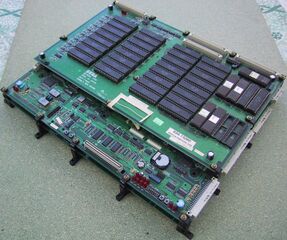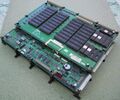Sega Model 3
From Sega Retro

| |||||
| Sega Model 3 | |||||
|---|---|---|---|---|---|
| Manufacturer: Sega | |||||
|
The Sega Model 3 is an arcade platform produced by Sega. It is a successor to the Sega Model 2 platform, and was released in 1996.
The Model 3 hardware is very different to the Model 1 and Model 2 boards which preceded it. The Model 3 used dual Real3D/PRO-1000 graphics processors as its GPU, designed by Lockheed Martin in partnership with Mitsubishi. The Model 3 was designed to push as many textured polygons as possible in real-time, along with the most advanced graphical techniques available at the time, such as multisample anti-aliasing, motion blur, facial animation, specular highlighting/reflection/shading, and multiple light sources. Upon release, the Model 3 board was more powerful than any other arcade platform on the market, as well as any home console or computer at the time; it took several years for home systems to catch-up to the Model 3.
The Model 3 was succeeded by the Sega NAOMI in 1998, followed by the Sega Hikaru in 1999 and Sega NAOMI 2 in 2000.
Contents
History
The Model 3 board went through a series of delays which frustrated Sega. Following their success with the Model 2's graphics chip, Lockheed Martin were unable to finalise the specifications of the Model 3's GPU, the Real3D/Pro-1000 graphics processors, until late 1995 or early 1996. Lockheed Martin partnered with Mitsubishi, which provided the GPU's ALU and graphics memory.[1] Sega had planned to release the board in late 1995 along with three games, one of which, Indy 500, was reportedly downgraded to Model 2 hardware thanks to the troubles. In late 1995, Yu Suzuki promised the Model 3 would deliver "the best 3D graphics".[2] When the Model 3 specification was finalized, it used two Real3D/Pro-1000 processors, including four 3D-RAM chips.[3] The Model 3 eventually debuted, with Virtua Fighter 3 as its first game, at the AOU Show 1996 in February 1996, and was followed by Scud Race later that year. The board was officially supported until 1999, to make room for the Sega NAOMI and its successors, the Sega Hikaru and NAOMI 2.
The Model 3 went through a number of revisions (steps) in which improvements were made the system and board architecture was changed. These "steppings" mainly increased the clock speed of the CPU and the speed of the 3D engine, as well as minor changes to the board architecture.[3] Step 1.0 and Step 1.5 released in 1996, Step 2.0 in 1997, and Step 2.1 in 1998. Though there was much talk of Model 3 games being ported to the Sega Saturn, all home ports of Model 3 games were seen on the Sega Dreamcast, including the likes of Sega Rally 2, Virtua Fighter 3tb, Virtual-On Oratorio Tangram and Virtua Striker 2.
It was the most powerful game system in its time, an order of magnitude more powerful than PC graphics cards from 1998, which were still producing Model 2 quality graphics, two years years after the Model 3's release.[4] By 2000, the Sega Model 2 & 3 had sold over 200,000 arcade systems worldwide,[5] making them some of the best-selling arcade game boards of all time. At around $15,000 each (for the Model 2, with the Model 3 costing higher), this amounts to at least over $3 billion revenue from cabinet sales, equivalent to over $4.9 billion in 2014.
From the early 1970s, arcades had been at the forefront of graphical technology in video games. The Model 3 hardware as well as competitors from this era were also leading the industry from a graphical perspective at the time, compared to PCs which were still producing Model 2 quality graphics in 1998,[4] but the gap began to slowly narrow after that, as PCs would begin to benefit from hardware accelerated graphics towards the end of the decade. Beginning with the co-development of the Sega Dreamcast console and Sega NAOMI arcade system, both released in 1998, consoles and later PCs would slowly become the basis for arcade systems, rather than the reverse as it had been up until this point. The last proprietary Sega arcade systems would be the Sega Hikaru and Sega NAOMI 2, after which PCs would overtake arcade systems as the forefront of graphical technology. Today, arcade games are built primarily around controls and the experience one gets from a game as opposed to graphical potential. Complex motion cabinets, and large, unique forms of control unsuitable for households is what drives the arcade industry in the present day.
Technical Specifications
Sound
- Sound CPU : Motorola 68000 (16/32-bit) @ 12 MHz [3] (2.1 MIPS)
- Sound Chip: 2× Yamaha SCSP/YMF292-F
- DSP: 2× "LAKE" FH1 128-step DSP
- PCM audio: 64 voices/channels, 16-bit depth, 44.1 kHz sampling rate (CD quality)
- Other features: MIDI interface, 32 MIDI channels, 32 FM synthesis channels, 32 LFO channels, 4-channel surround sound, 16.5 MB audio ROM
- Optional sound board: MPEG Sound Board
- Sound CPU: Motorola 68000 or Zilog Z80
- Sound chip: NEC uD65654GF102
- Features: MPEG audio compression, stereo output, steam individual mono channels to left and right speakers
Graphics
- Video Board: [3]
- Step 1.0: Sega 837-11859 MODEL3
- Step 1.5: Sega 837-12875 MODEL3 STEP 1.5
- Step 2.0: Sega 837-12716 MODEL3 STEP2
- Step 2.1: Sega 837-13368 MODEL3 STEP2.1
- Display Resolution: 496×384 to 640x480, progressive scan (non-interlaced), 24 kHz horizontal sync, one or two planes
- Color Depth: 32-bit ARGB,[3] 24-bit RGB true color (16,777,216 colors) and alpha opacity
- Scroll Window: Two planes (24 kHz, two plane mode), 16 colors/32,768 1024 palette x 2 bank, 256/32,768 64 palette x 2 bank
Step 1.0
- GPU: 2× Lockheed Martin Real3D/Pro‑1000 @ 50 MHz [3][7][1][8]
- ALU: 4× Mitsubishi 3D‑RAM @ 33 MHz [9][10][11][12]
- Functional blocks: 4× 32-bit Pixel ALU (33 MHz), 4× 256-bit Global Bus (16 MHz), 4× 256/32-bit triple-port SRAM Pixel Buffer cache (16/33 MHz), 4× 1280-bit (8× 640-bit) SAM Video Buffers (27 MHz), 4× 128-bit (16× 32-bit) dual-port SDRAM banks (16 MHz)
- Render output units: 16 (4× 4) ROP/blend units (8-bit), 8 (4× 2) Z-compare units (32-bit)
- Features: Blending, depth check, stencil & raster operations,[13] alpha blending, tiled rendering, 32-bit Z‑compare, 16/24/32-bit Z-buffering, hidden surface removal, 30-85 Hz refresh rate, OpenGL support
- Framebuffers: 512×486 to 1280×1024 (16/24/32-bit), Z-buffer (16/24/32-bit)
- Framebuffer bandwidth: 2.062 GB/sec (4× 528 MB/sec)
- Framebuffer fillrate: 2.112 billion pixels/sec (erase), 528 million pixels/sec (write), 264 million pixels/sec (read)
- ALU performance: 528 million operations/sec, 7 million vectors/sec, 4 million triangle polygons/sec, 4 million tiles/sec
- ALU polygon fillrate: 300 million pixels/sec (write)
- Geometrizers: 2 custom ASIC geometry processors, 2 floating-point units (32-bit)
- Geometrizer features: T&L (transform, clipping, lighting), culling, 24-bit hidden surface removal, clipping, 24-bit floating-point Z-buffering, depth buffer, stencil buffer, particle effects
- Lighting: Parallel light, pin-point light, 4 light spots, 4 spot lights, pin spot light, specular reflection, specular highlighting, headlight illumination, landing lights, glare effects, sunlight
- Geometrizer performance: 2,000,200 textured triangle polygons/sec (1,000,100 textured quad polygons/sec) with effects (shading, translucency, anti-aliasing, fog, lighting, Z-buffering)
- Renderers: 2 pixel processors
- Anti-aliasing: Texture anti-aliasing, multi-layered anti-aliasing (multi-sample anti-aliasing), texture & edge multi-layered anti-aliasing, S-buffer anti-aliasing technology
- Renderer polygon fillrate: 100 million pixels/sec (write)
- Texture mapping: Full color texture mapping, mipmapping, perspective correction, texture filtering, Trilinear filtering, trilinear interpolation, trilinear mipmapping, mipmapped trilinear interpolation texture mapping algorithms, reflection/environment mapping, 32×32 to 1024×1024 texture sizes
- Texture RAM: 8 MB (16× 512 KB) Mitsubishi Cached SDRAM (33 MHz), 2× 64-bit (8× 16-bit),[14] 2.062 GB/sec (8× 264 MB/sec) texture RAM bandwidth,[15] dual 2048×1024 texture sheets (4.2 million texels per frame)
- Texture fillrate: 251 million texels/sec (color), 1.006 billion texels/sec (grayscale), 16 million colored textures/sec
- Shading: Flat shading, Gouraud shading, high-specular Gouraud shading, micro texture shading, fix shading, flat sun shading
- Special effects: Zoning fog, 32 levels of translucency, model & texture LOD, fade in/out, 4095 moving models, motion blur
- ALU: 4× Mitsubishi 3D‑RAM @ 33 MHz [9][10][11][12]
Step 1.5
- GPU: 2× Lockheed Martin Real3D/Pro‑1000 @ 66 MHz [3]
- ALU: 4× Mitsubishi 3D‑RAM @ 33 MHz
- Framebuffer fillrate: 2.112 billion pixels/sec (erase), 528 million pixels/sec (write), 264 million pixels/sec (read)
- ALU performance: 528 million operations/sec, 7 million vectors/sec, 4 million triangle polygons/sec, 4 million tiles/sec
- ALU polygon fillrate: 300 million pixels/sec (write)
- Functions/Features/Framebuffers: Same as Step 1.0
- Geometrizers: 2 custom ASIC geometry processors, 2 floating-point units (32-bit)
- Geometrizer performance: 2.666 million textured triangle polygons/sec (1.333 million textured quad polygons/sec) with effects (shading, translucency, anti-aliasing, fog, lighting, Z-buffering)
- Features/Lighting: Same as Step 1.0
- Renderers: 2 pixel processors
- Renderer polygon fillrate: 133 million pixels/sec (write)
- Anti-aliasing: Same as Step 1.0
- ALU: 4× Mitsubishi 3D‑RAM @ 33 MHz
Memory
- Memory: Up to 285.16504 MB (128 MB main, 123.15723 MB video, 33.69533 MB audio, 320 KB other)
- RAM: 32.54004 MB (33,321 KB) [3]
- Main RAM: 8 MB (8192 KB) @ 66 MHz
- VRAM: 23,713 KB (5 MB framebuffer, 8 MB textures, 33 KB SRAM cache, 1 MB display list, 4 MB culling, 4 MB polygons, 1152 KB tilemap generator VRAM) [8]
- Framebuffer: 5 MB (4× 1.25 MB) Mitsubishi 3D-RAM (5 MB framebuffer Video SDRAM, 1 KB pixel buffer SRAM cache) [16]
- Texture RAM: 8 MB (16× 512 KB) Mitsubishi Cached SDRAM (8 MB SDRAM, 32 KB SRAM cache) [14]
- 4 MB (8× 512 KB) Hitachi SDRAM [17]
- Audio RAM: 1096 KB (64 KB main, 1032 KB SCSP; 512 KB per SCSP chip)
- Other RAM: 320 KB (192 KB security, 128 KB backup static NVRAM)
- ROM: Up to 252.625 MB (120 MB main,[18] 100 MB video/texture/graphics Mask ROM,[19] 32.625 MB audio ROM) [18]
- ROM access time: 100 nanoseconds[19]
- High-speed access allows ROM to effectively be used as RAM, and textures streamed directly from ROM.[19]
- RAM: 32.54004 MB (33,321 KB) [3]
Hardware Images
List of Games
Step 1.0
- Boat Race GP (1996)
- Virtua Fighter 3 (1996)
- Virtua Fighter 3tb (1997)
- Sega Bass Fishing/Get Bass (1998)
Step 1.5
- Scud Race / Super GT (1996)
- Le Mans 24 (1997)
- Scud Race Plus (1997)
- The Lost World: Jurassic Park (1997)
- The Lost World: Jurassic Park Special (1997)
- Virtua Striker 2 (1997)
- Virtua Striker 2 Version '98 (1998)
Step 2.0
- Harley Davidson & L.A. Riders (1997)
- Fighting Vipers 2 (1998)
- Sega Rally 2 (1998)
- Ski Champ (1998)
- Virtua Striker 2 (1997)
- Virtua Striker 2 Version '98 (1998)
- Virtua Striker 2 Version '99 (1999)
- Virtua Striker 2 Version '99.1 (1999)
- Virtual-On Oratorio Tangram (1998)
Step 2.1
- Daytona USA 2 (1998)
- Daytona USA 2: Power Edition (1998)
- Dirt Devils (1998)
- L.A. Machineguns (1998)
- Spike Out (1998)
- Star Wars Trilogy Arcade (1998)
- The Ocean Hunter (1998)
- Emergency Call Ambulance (1999)
- Magical Truck Adventure (1999)
- Spikeout: Final Edition (1999)
- Virtua Striker 2 '99 (1999)
| Sega arcade boards |
|---|
| Originating in arcades |
|
77
78
79
80
81
82
83
84
85
86
87
88
89
90
91
92
93
94
95
96
97
98
99
|
| Console-based hardware |
|
84
85
86
87
88
89
90
91
92
93
94
95
96
97
98
99
00
01
02
03
04
05
06
07
08
09
10
11
12
13
14
|
| PC-based hardware |
|
05
06
07
08
09
10
11
12
13
14
15
16
17
18
19
20
21
22
23
|



